Cultivated Land Changes and Agricultural Potential Productivity in Mainland China
Abstract
:1. Introduction
2. Materials and Methods
2.1. Data Sources
2.1.1. Cultivated Land Data
2.1.2. Meteorological Data
2.1.3. Terrain Elevation Data and Soil Data
2.2. Methodology
2.2.1. Potential Productivity Calculation
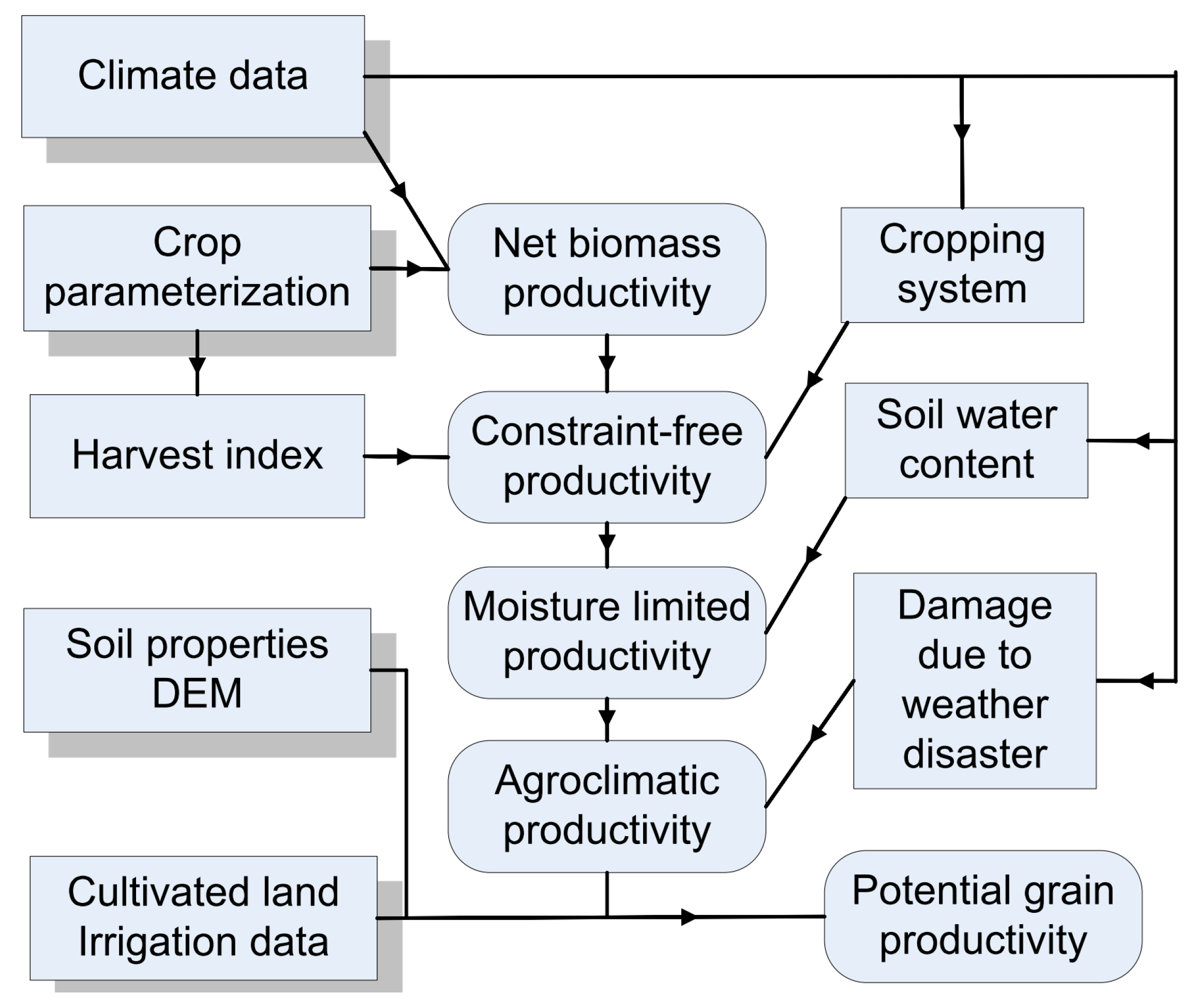
2.2.2. Evaluation Method for Changes in Potential Productivity
3. Results and Discussions
3.1. Potential Productivity of Mainland China in 2012
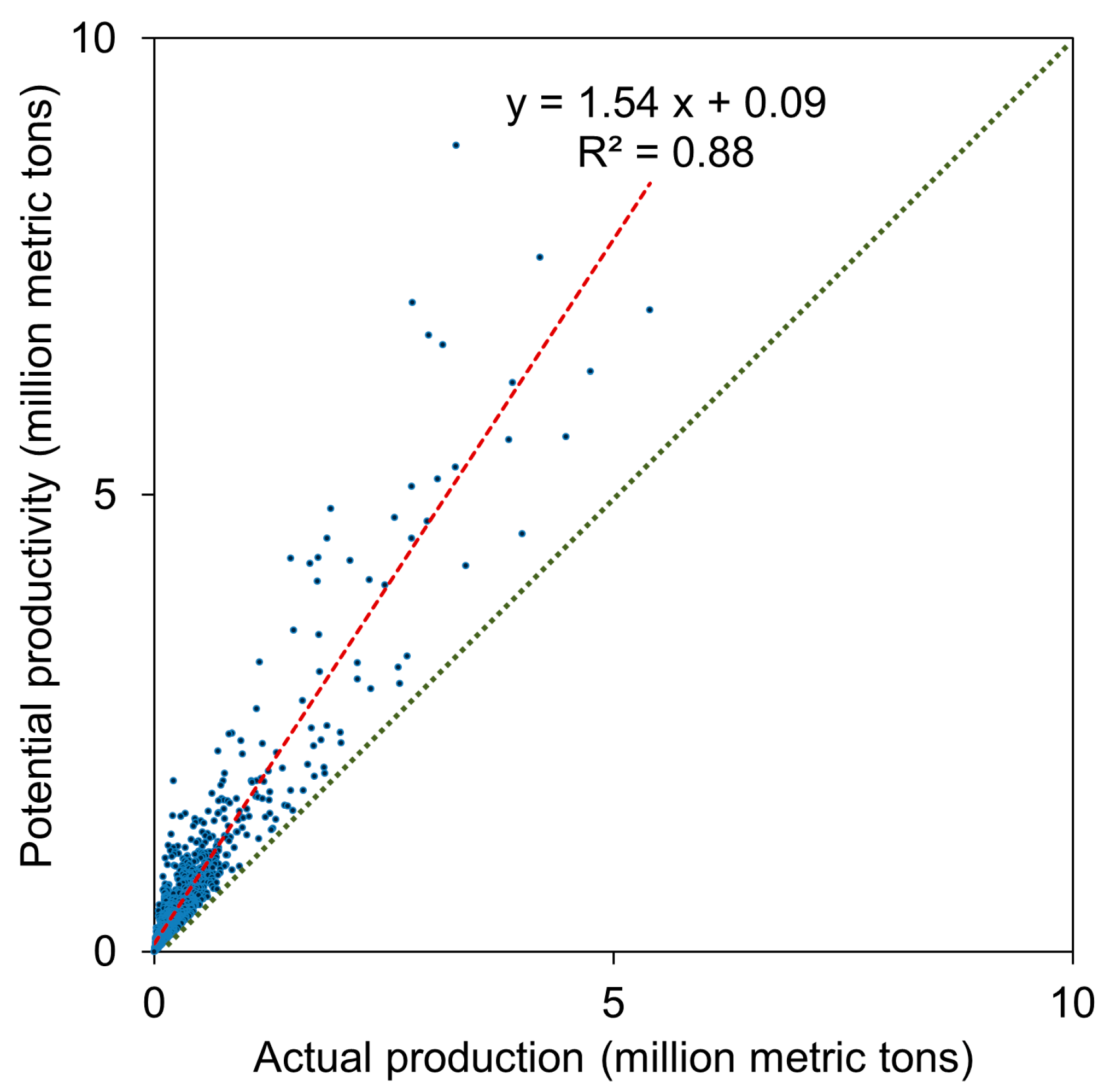
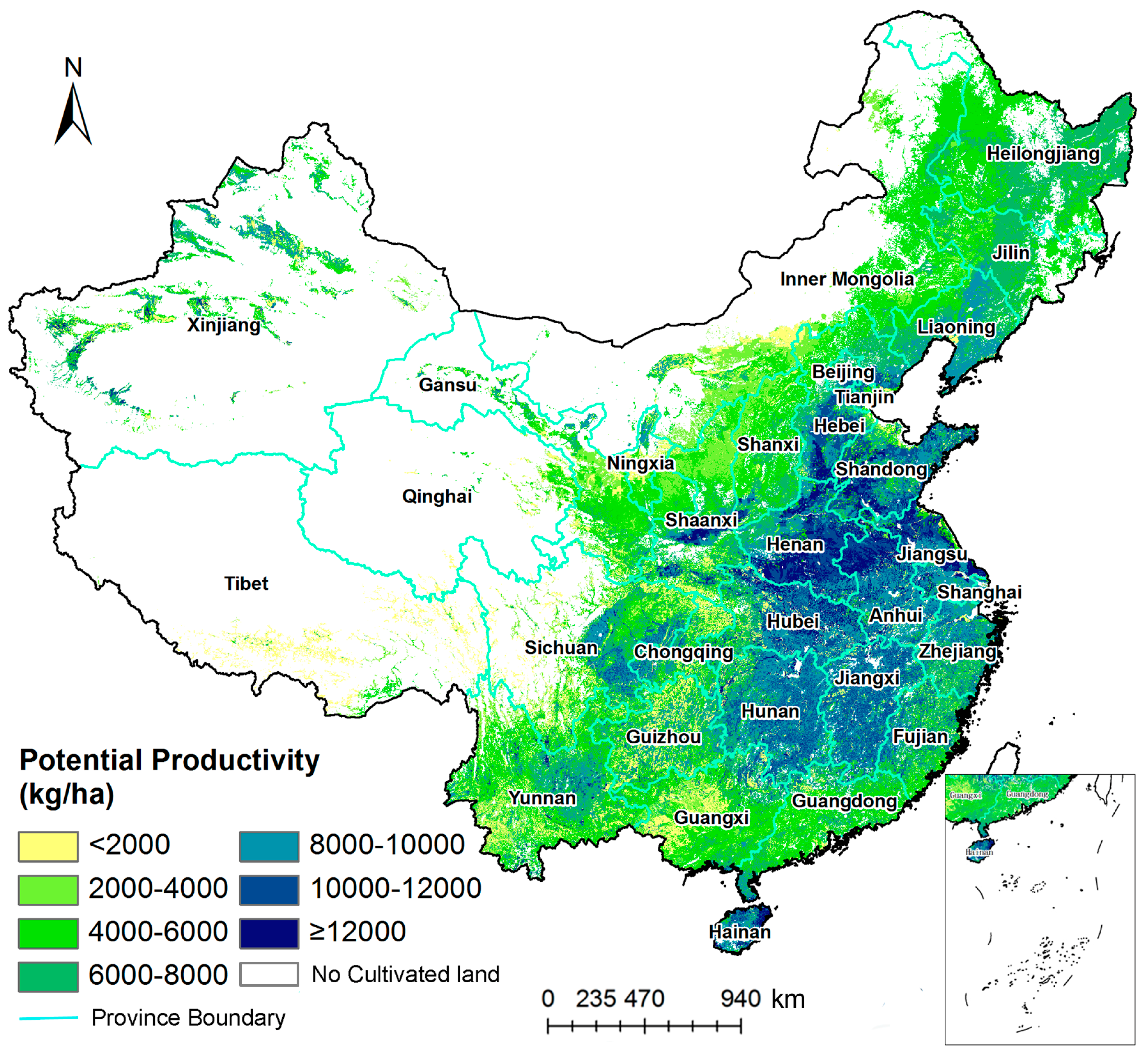
3.2. Changes in Cultivated Land and Their Influence on Potential Productivity
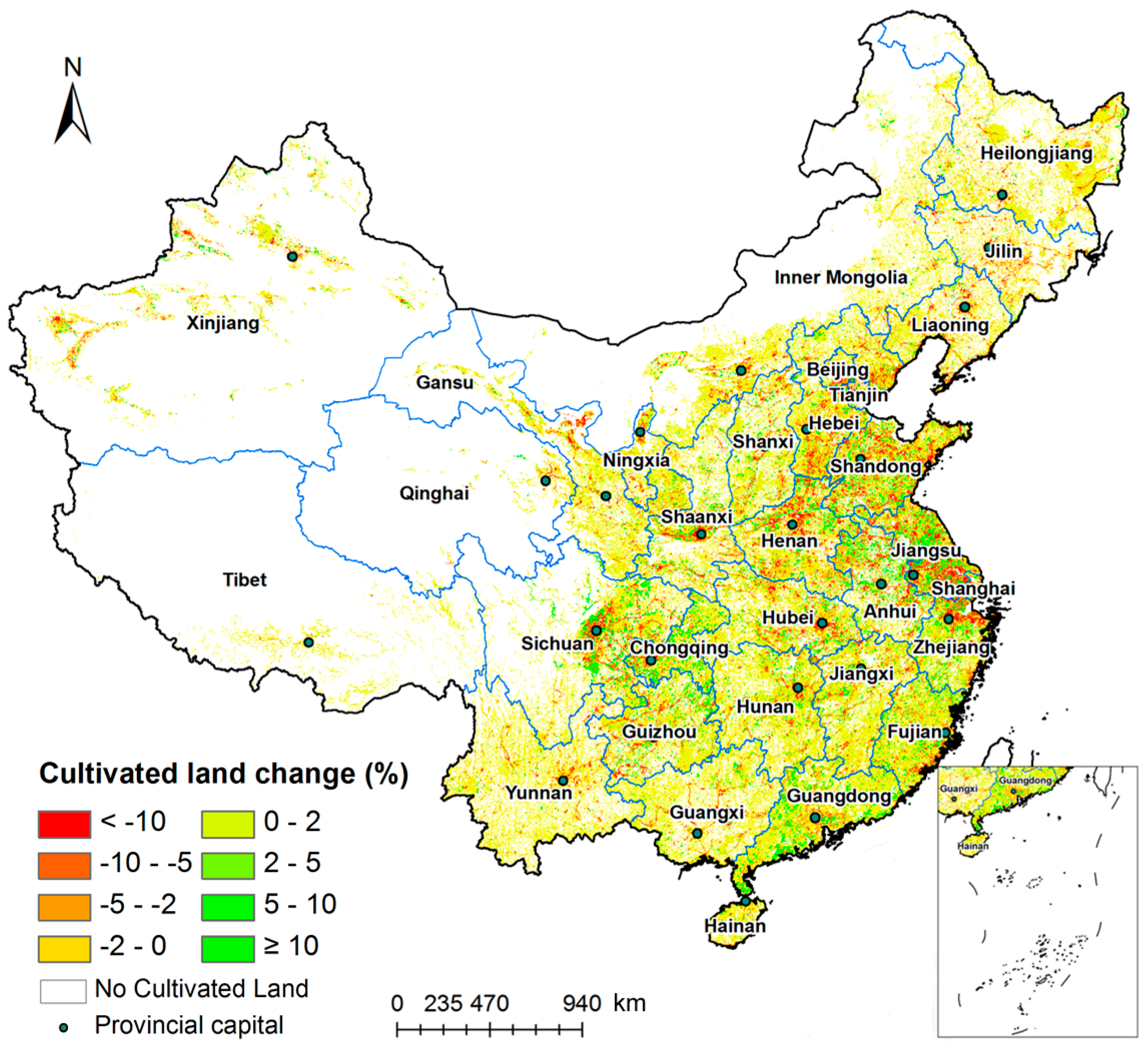
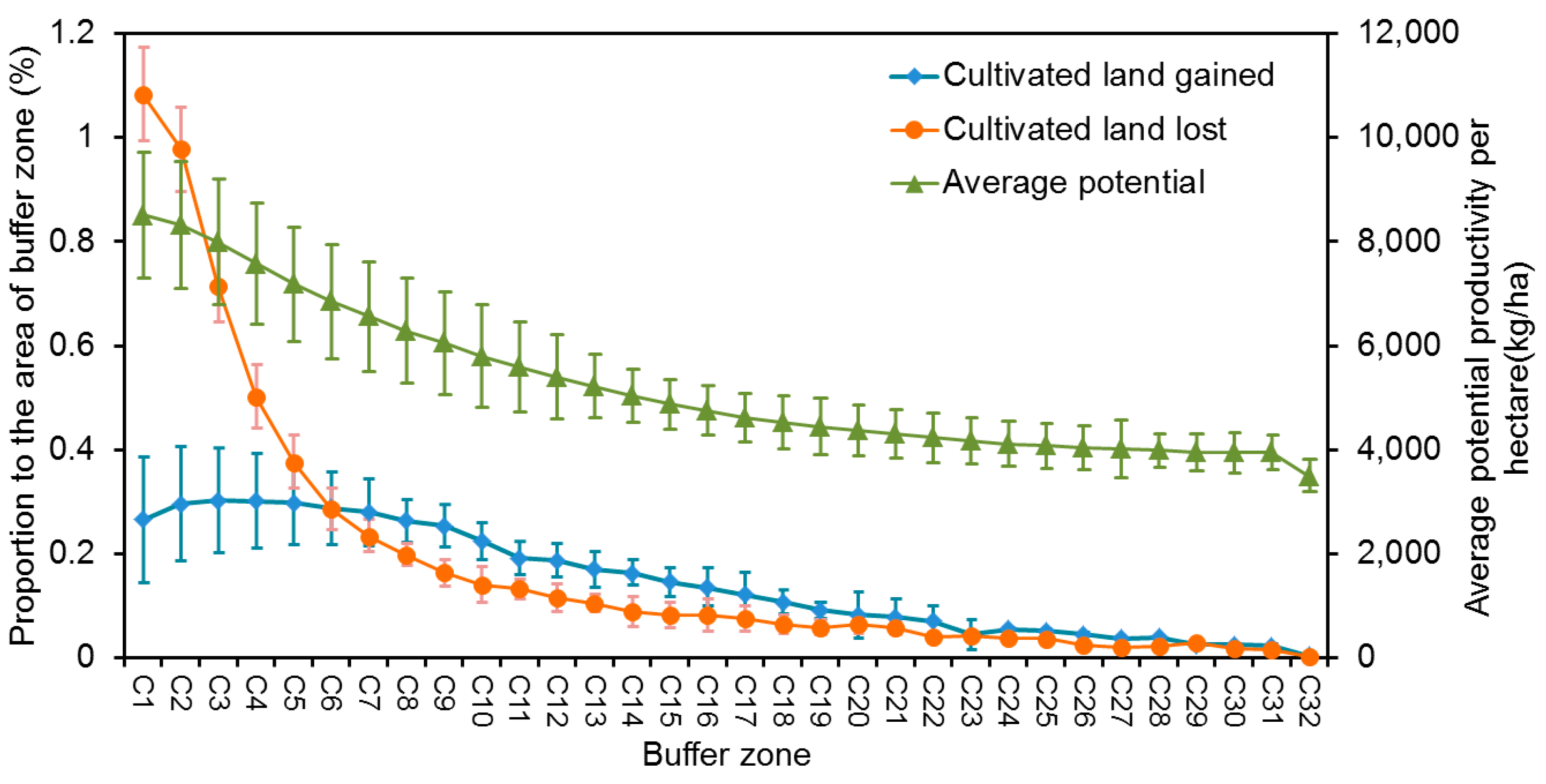
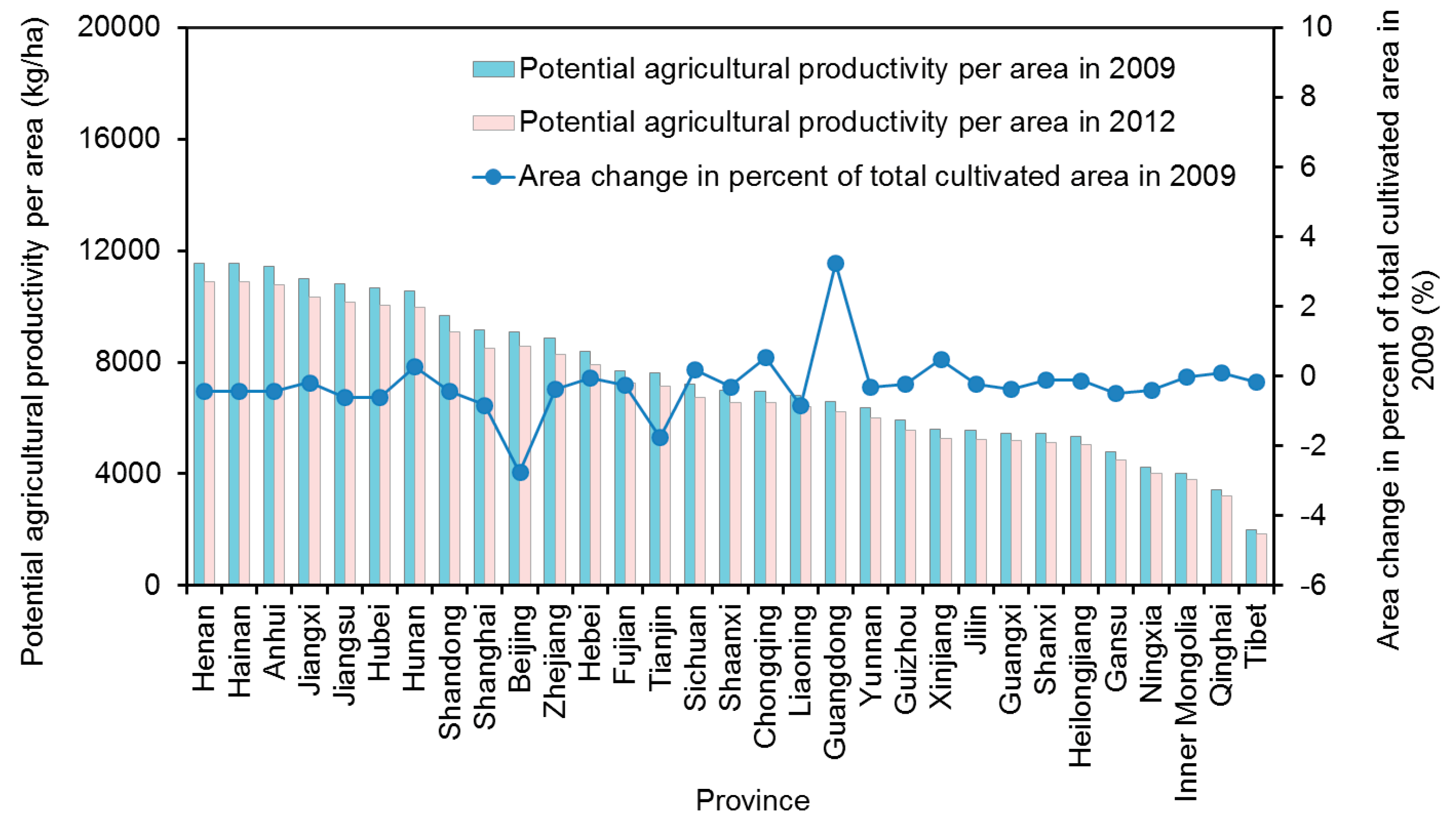
3.3. The Utilization of Potential Productivity

4. Conclusions
Acknowledgments
Author Contributions
Conflicts of Interest
References
- Tan, M.H.; Li, X.B.; Lu, C.H. Urban land expansion and arable land loss of the major cities in China in the 1990s. Sci. China Ser. D 2005, 48, 1492–1500. [Google Scholar] [CrossRef]
- Song, W.; Pijanowski, B.C.; Tayyebi, A. Urban expansion and its consumption of high-quality farmland in Beijing, China. Ecol. Indic. 2015, 54, 60–70. [Google Scholar] [CrossRef]
- Ramankutty, N.; Foley, J.A.; Olejniczak, N.J. People on the land: changes in global population and croplands during the 20th Century. J. Hum. Environ. 2002, 31, 251–257. [Google Scholar] [CrossRef]
- Liu, J.Y.; Liu, M.L.; Zhuang, D.F.; Zhang, Z.X.; Deng, X.Z. Study on spatial pattern of land-use change in China during 1995–2000. Sci. China Ser. D 2003, 46, 373–384. [Google Scholar]
- Ministry of Land and Resources of China (MLRC). Land Yearbook of China; Land Publishing House: Beijing, China, 1997; pp. 50–91. [Google Scholar]
- Song, W.; Pijanowski, B.C. The effects of China’s cultivated land balance program on potential land productivity at a national scale. Appl. Geogr. 2014, 46, 158–170. [Google Scholar] [CrossRef]
- Feng, Z.M.; Liu, B.Q.; Yang, Y.Z. A study of the changing trend of Chinese cultivated land amount and data reconstructing: 1949–2003. J. Nat. Resour. 2005, 20, 35–43. [Google Scholar]
- Liu, J.Y.; Liu, M.L.; Tian, H.Q.; Zhuang, D.F.; Zhang, Z.X.; Zhang, W.; Tang, X.M.; Deng, X.Z. Spatial and temporal patterns of China’s cropland during 1990–2000: An analysis based on Landsat TM data. Remote Sens. Environ. 2005, 98, 442–456. [Google Scholar] [CrossRef]
- Yang, X.H.; Cheng, C.Z.; Li, Y.J. Effect of Cropland Occupation and Supplement on Light-temperature Potential Productivity in China from 2000 to 2008. Chin. Geogr. Sci. 2010, 20, 536–544. [Google Scholar] [CrossRef]
- Cao, M.; Ma, S.; Han, C. Potential productivity and human carrying capacity of an agro-ecosystem: an analysis of food production potential of China. Agric. Syst. 1995, 47, 387–414. [Google Scholar] [CrossRef]
- Weinhold, D. Estimating the loss of agricultural productivity in the Amazon. Ecol. Econ. 1999, 31, 63–76. [Google Scholar] [CrossRef]
- Washington-Ottombre, C.; Pijanowski, B.; Campbell, D.; Olson, J.; Maitima, J.; Musili, A. Using a roleplaying game to inform the development of land-use models for the study of a complex socio-ecological system. Agric. Syst. 2010, 103, 117–126. [Google Scholar] [CrossRef]
- Huang, J.K.; Rozelle, S. Environmental-stress and grain yields in China. Am. J. Agric. Econ. 1995, 77, 853–864. [Google Scholar] [CrossRef]
- Wang, Q.B.; Halbrendt, C.; Johnson, S.R. Grain production and environmental management in China’s fertilizer economy. J. Environ. Manag. 1996, 47, 283–296. [Google Scholar] [CrossRef]
- Feng, Z.; Li, X. The strategy of cultivated land and food supplies security: storing food in land—raising the comprehensive productivity of land resource of China. Geogr. Territ. Res. 2000, 16, 1–5. (In Chinese) [Google Scholar]
- Yan, H.M.; Liu, J.Y.; Huang, H.Q.; Tao, B.; Cao, M.K. Assessing the consequence of land use change on agricultural productivity in China. Glob. Planet. Change 2009, 67, 13–19. [Google Scholar] [CrossRef]
- Yang, H.; Li, X.B. Cultivated land and food supply in China. Land Use Policy 2000, 17, 73–88. [Google Scholar] [CrossRef]
- Lu, J.; Xu, C. The Construction of the Assurance System of Food Security in China. Issues Agric. Econ. 2004, 8, 29–79. (In Chinese) [Google Scholar]
- Yu, L.; Zhao, F. Radiation and heat resources and crop photosynthetic and heat potential productivity. J. Meteorol. 1982, 3, 327–334. (In Chinese) [Google Scholar]
- Zhang, J.K.; Zhang, F.R.; Zhang, D.; He, D.X.; Zhang, L.; Wu, C.G.; Kong, X.B. The grain potential of cultivated lands in Mainland China in 2004. Land Use Policy 2008, 26, 68–76. [Google Scholar] [CrossRef]
- Cai, Y.; Fu, Z.; Dai, E. The minimum area per capita of cultivated land and its implication for the optimization of land resource allocation. Acta Geogr. Sin. 2002, 57, 127–134. (In Chinese) [Google Scholar]
- Ash, R.F.; Edmonds, R.L. China’s land resources, environment and agricultural production. China Q. 1998, 156, 836–879. [Google Scholar] [CrossRef]
- Smil, V. China’s agricultural land. China Q. 1999, 158, 414–429. [Google Scholar] [CrossRef]
- Lichtenberg, E.; Ding, C.G. Assessing farmland protection policy in China. Land Use Policy 2008, 25, 59–68. [Google Scholar] [CrossRef]
- He, J.H.; Liu, Y.L.; Yu, Y.; Tang, W.W.; Xiang, W.N.; Liu, D.F. A counterfactual scenario simulation approach for assessing the impact of farmland preservation policies on urban sprawl and food security in a major grain-producing area of China. Appl. Geogr. 2013, 37, 127–138. [Google Scholar] [CrossRef]
- Huang, J.K.; Zhu, L.; Deng, X. Regional differences and determinants of built-up area expansion in China. Sci. China Ser. D 2007, 50, 1835–1843. [Google Scholar] [CrossRef]
- Zhuang, D.; Liu, J.; Liu, M. Research activities on land use/land cover in the past ten years in China using space technology. Chin. Geogr. Sci. 1999, 4, 330–334. [Google Scholar] [CrossRef]
- Liu, J.Y.; Zhang, Z.X.; Xu, X.L.; Kuang, W.H.; Zhou, W.C.; Zhang, S.W.; Li, R.D.; Yan, C.Z.; Yu, D.S.; Wu, S.X.; et al. Spatial patterns and driving forces of land use change in China during the early 21st century. J. Geogr. Sci. 2010, 20, 483–494. [Google Scholar] [CrossRef]
- Liu, X.; Cai, S.B. 3S technology application in the second national land survey. Geomat. Spat. Inf. Technol. 2013, 36, 111–114. (In Chinese) [Google Scholar]
- Qiu, D.H.; Tian, S.F. The choice of aerospace remote sensing data in the second national land survey. Guangdong Land Sci. 2008, 7, 4–7. (In Chinese) [Google Scholar]
- Ma, L.Q. Research on the second land survey data classification of sharing mechanism. Territ. Nat. Resour. Study 2012, 6, 20–21. (In Chinese) [Google Scholar]
- Zhang, D.X.; Chen, H.L.; Li, H.W.; Li, S.J.; Fu, Q. National grating data production methods of land use. Land Resour. Inf. 2014, 2, 32–38. (In Chinese) [Google Scholar]
- Wei, H.L.; Xu, Q.S.; Zhang, T.S. Observation of solar irradiance at the surface from GMS-5. J. Remote Sens. 2003, 7, 465–471. (In Chinese) [Google Scholar]
- Xiao, L.L.; Yang, X.H.; Chen, S.X.; Cai, H.Y. An assessment of erosivity distribution and its influence on the effectiveness of land use conversion for reducing soil erosion in Jiangxi, China. Catena 2015, 125, 50–60. [Google Scholar] [CrossRef]
- Liu, L.; Xu, X.L.; Chen, X. Assessing the impact of urban expansion on potential crop yield in China during 1990–2010. Food Secur. 2014, 7, 33–43. [Google Scholar] [CrossRef]
- Heilig, G.K.; Fischer, G.; van Velthuizen, H.T. Can China feed itself? An analysis of China’s food prospects with special reference to water resources. Int. J. Sustain Dev. World Ecol. 2000, 7, 153–172. [Google Scholar] [CrossRef]
- Tatsumi, K.; Yamashiki, Y.; Roberto, V.D.S.; Takara, K.; Matsuoka, Y.; Takahashi, K.; Maruyama, K.; Kawahara, N. Estimation of potential changes in cereals production under climate change scenarios. Hydrol. Process. 2011, 25, 2715–2725. [Google Scholar] [CrossRef]
- Fischer, G.; Sun, L. Model based analysis of future land-use development in China. Agric. Ecosyst. Environ. 2001, 85, 163–176. [Google Scholar] [CrossRef]
- Deng, X.Z.; Huang, J.K.; Rozelle, S.; Uchida, E. Cultivated land conversion and potential agricultural productivity in China. Land Use Policy 2006, 23, 372–384. [Google Scholar] [CrossRef]
- Morschel, J.; Fox, D.M.; Bruno, J.F. Limiting sediment deposition on roadways: topographic controls on vulnerable roads and cost analysis of planting grass buffer strips. Environ. Sci. Policy 2004, 7, 39–45. [Google Scholar] [CrossRef]
- Foley, J.A.; DeFries, R.; Asner, G.P.; Barford, C.; Bonan, G.; Carpenter, S.R. Global consequences of land use. Science 2005, 309, 570–574. [Google Scholar] [CrossRef] [PubMed]
- Tsadila, E.; Evangelou, L.; Tsadilas, C.; Giourga, C.; Stamatiadis, S. Land-use effect on selected soil quality parameters. Commun. Soil Sci. Plant Anal. 2012, 43, 595–604. [Google Scholar] [CrossRef]
- Ramankutty, N.; Delire, C.; Snyder, P. Feedbacks between agriculture and climate: An illustration of the potential unintended consequences of human land use activities. Glob. Planet. Change 2006, 54, 79–93. [Google Scholar] [CrossRef]
- Selvaraju, R.; Gommes, R.; Bernardi, M. Climate science in support of sustainable agriculture and food security. Clim. Res. 2011, 47, 95–110. [Google Scholar] [CrossRef]
- Qin, Y.W.; Liu, J.Y.; Shi, W.J.; Tao, F.L.; Yan, H.M. Spatial-temporal changes of cropland and climate potential productivity in northern China during 1990–2010. Food Secur. 2013, 5, 499–512. [Google Scholar] [CrossRef]
- Chen, Y.F.; Li, X.D. Spatial-temporal characteristics and influencing factors of grain yield change in China. Trans. Chin. Soc. Agric. Eng. 2013, 29, 1–10. (In Chinese) [Google Scholar]
- Tilman, D.; Fargione, J.; Wolff, B.; D’Antonio, C.; Dobson, A.; Howarth, R. Forecasting agriculturally driven global environmental change. Science 2001, 292, 281–284. [Google Scholar] [CrossRef] [PubMed]
- Fan, M.S.; Shen, J.B.; Yuan, L.X.; Jiang, R.F.; Chen, X.P.; Davies, W.J; Zhang, F.S. Improving crop productivity and resource use efficiency to ensure food security and environmental quality in China. J. Exp. Bot. 2012, 63, 13–24. [Google Scholar] [CrossRef] [PubMed]
- Lin, J.Y. The household responsibility system reform in China—A peasants institutional choice. Am. J. Agric. Econ. 1987, 69, 410–415. [Google Scholar] [CrossRef]
© 2015 by the authors; licensee MDPI, Basel, Switzerland. This article is an open access article distributed under the terms and conditions of the Creative Commons Attribution license (http://creativecommons.org/licenses/by/4.0/).
Share and Cite
Xiao, L.; Yang, X.; Cai, H.; Zhang, D. Cultivated Land Changes and Agricultural Potential Productivity in Mainland China. Sustainability 2015, 7, 11893-11908. https://doi.org/10.3390/su70911893
Xiao L, Yang X, Cai H, Zhang D. Cultivated Land Changes and Agricultural Potential Productivity in Mainland China. Sustainability. 2015; 7(9):11893-11908. https://doi.org/10.3390/su70911893
Chicago/Turabian StyleXiao, Linlin, Xiaohuan Yang, Hongyan Cai, and Dingxiang Zhang. 2015. "Cultivated Land Changes and Agricultural Potential Productivity in Mainland China" Sustainability 7, no. 9: 11893-11908. https://doi.org/10.3390/su70911893





